USU System
As part of its land-grant mission, USU strives to allow access to education for as many people as possible. Part of this includes accepting nearly all applicants who qualify according to an admissions index. In addition, beyond its Logan campus, USU's Regional Campus and Distance Education (RCDE) community provides academic resources and support throughout the state, including a Continuing Education program. Created in 1907, RCDE now includes USU Regional Campuses in Brigham City, Tooele, and the Uintah Basin, as well as education centers in Moab, Ogden, Orem, Salt Lake City, and elsewhere. USU also operates Extension locations in each of Utah's 29 counties.
On March 4, 2010, USU and the College of Eastern Utah signed an agreement to officially affiliate the two institutions. On July 1, CEU's two campuses in Price and San Juan will cease independent operations and collectively receive comprehensive regional college status within the USU system. They will, however, retain some semblance of their own brand, including their own athletics, which will continue to compete in the NJCAA as the Eastern Utah Golden Eagles.
历史
Background and founding
On December 16, 1861, Justin Morrill (VT) introduced a bill into the U.S. House of Representatives, "to establish at least one college in each state upon a sure and perpetual foundation, accessible to all, but especially to the sons of toil..." President Abraham Lincoln signed the Morrill Land-Grant Colleges Act into effect in July of the following year.
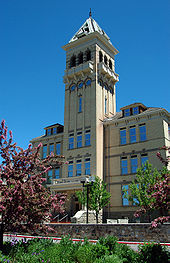
Old Main, the agricultural college's now-iconic first building, now houses administrative offices and much of the College of HSS
Meanwhile, after visiting a few rural agricultural schools in his native Denmark, Anthon H. Lund of the Utah Territorial Legislature decided that there existed in Utah a need for such a school fusing the highest in scientific and academic research with agriculture, the way of life for the vast majority of locals. Upon returning to the states, Lund heard about the Morrill Act, and pitched a vision for the college that would receive widespread support among the Territorial Legislature, who was at the time seeking to reapply for statehood. Now there came the question of location. According to historian Joel Ricks in 1938, "Provo had received the Insane Asylum, Salt Lake City had the University and Capitol, and the majority of the legislature felt that the new institutions should be given to Weber and Cache Counties." Citizens in Logan, Cache County, banded together and successfully lobbied representatives for the honor. The bill to establish the Agricultural College of Utah was passed on March 8, 1888, and on September 2, 1890, 14-year-old Miss Vendla Berntson enrolled as its first student.
Consolidation controversies
In its early years, the college narrowly dodged two major campaigns to consolidate its operations with the University of Utah. Much controversy arose in response to President William J. Kerr's expansion of the college's scope beyond its agricultural roots. Detractors in Salt Lake City feared that such an expansion would come at the expense of the University of Utah, and pushed consolidation as a counter.
In 1907, an agreement was struck to instead limit the curricula of the Agricultural College strictly to agriculture, domestic science, and mechanic arts. This meant closing all departments in Logan, including the already-impressive music department, which did not fall under that umbrella. Consequently, the University of Utah became solely responsible, for a time, for courses in engineering, law, medicine, fine arts, and pedagogy, despite the Agricultral College's initial charter in 1888 which mandated that it offer instruction in such things. The bulk of the curricular restrictions were lifted over the next two decades, with the exception of law and medicine, which have since remained the sole property of the University of Utah.
Widespread growth
Amid the tumult, the Agricultural College grew modestly, adding its statewide Extension program in 1914. A year later, the first master's degrees were awarded. UAC, as it was commonly abbreviated, also received a notable boost as a direct result of World War I. Colleges and universities nationwide were temporarily transformed into training grounds for the short-lived Student Army Training Corps, composed of students who received military instruction and could then return to their educations following their military service. As the then-tiny campus could not otherwise support such large numbers of new students, college president Elmer Peterson convinced the state in 1918 to appropriate funds for permanent brick buildings, which could be used as barracks for SATC students during the war, and instruction afterward. Though the war was soon to end, the campus essentially doubled in size.
The 1920s and 1930s saw the genesis of major growth, especially with the acceptance of the college into the Association of American Universities in 1926. Doctoral degrees were first granted in 1950, and the college became known as Utah State University in 1957.
During the late 1970s, controversy again erupted on campus surrounding the school's historically large Iranian population. As U.S. relations with Iran began to deteriorate throughout the decade, Iranian students on campus began staging protests against the Shah, which protests met with some backlash in the community. Following the outbreak of the hostage crisis of 1979, immigration officials arrived on campus to interview each Iranian, an event which alienated many international and domestic students. For a time, the population of Middle Eastern students declined sharply and has only recently begun to rise again.
Toward the end of the 20th century, Utah State began taking more strides to shed its reputation as a smallish regional college and transform itself into a nationally prominent university. Under the auspices of President George Emert, who served at USU's helm from 1992 to 2000, the university's endowment increased from $7 million to $80 million. Scholarships, contracts, and grants increased substantially as well.
21st century
Recently, especially under the tenure of current president Stan Albrecht, USU has forged collaborations with several foreign institutions and governments. The university is continuing to grow in enrollment, endowment, and research. The brand new Merrill-Cazier Library opened in 2005, and other facilities have followed. The university is currently in the midst of a $400 million fundraising campaign—the largest ever at USU—which Albrecht has said will go down in history as one of USU's most pivotal moments.
Logan 校园
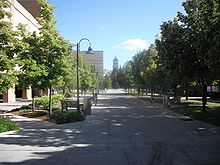
View of Old Main from outside the Taggart Student Center
USU's main campus in Logan is considered one of the university's greatest assets. It is situated on about 500 acres, approximately one mile northeast of downtown Logan, at the mouth of Logan Canyon. The campus lies on a "bench," or shelf-like foothill overlooking the valley to the west. Mount Logan and the Wasatch Range rise sharply to the immediate east. The campus contains over a hundred major buildings. Most student activity is centered around the south end of campus, which is home to the vast majority of academic departments, the quad, the Taggart Student Center, and the Old Main building.
Notable structures include Old Main, the college's first building, as well as the Merrill-Cazier Library, the 305,000-sq.ft. ultra-modern main university library, which houses over 1,549,000 total volumes. The library also boasts an extensive special collections and archives area, an automated storage and retrieval system, and over 150 workstations and 33 group study rooms. Also notable is the Manon Caine Russell-Kathryn Caine Wanlass Performance Hall, an architectural marvel which is said to contain some of the best acoustics in the entire Western United States. Most students live on or near campus, and many arrive via university shuttles, which service the neighborhoods nearby.
The Logan City Cemetery splits much of the campus in half. To the south lie most academic buildings, and to the west and north are situated the Dee Glen Smith Spectrum and Romney Stadium, respectively. Many scientific and agricultural research buildings are located even farther north, on the shuttle lines. Nearby Logan Canyon is a popular recreation destination for students, with a system of trails and parks running along the river. In addition to camping and hiking, the canyon also serves as the primary route to nearby Beaver Mountain Ski Resort and Bear Lake. The university's Outdoor Recreation Center rents camping, water sports, mountain sports, and winter sports equipment to students, as well as providing them with area trail maps and expertise for their ventures into the canyon and elsewhere.
With the 2010 gift of the Swaner EcoCenter to the university, USU now owns and operates over 8,200 acres of land and facilities throughout the state.
Student Life
Utah State is the largest public residential campus in the state, and nearly 14,000 students live on or directly adjacent to campus. The university is the center of activity for the entire area, and the campus community is considered very close-knit. 21 widely-varying on-campus buildings house single students, and 39 buildings on the north side of campus are available for married housing. Many more students live in the multitude of off-campus housing options nearby. Students on campus may choose to dine in one of two cafeterias, as well as the Quadside Cafe at Merrill-Cazier Library, the full-service Skyroom restaurant, and the Hub, which includes fast-food restaurants such as Hogi Yogi and Taco Time. On the east edge of campus sits Aggie Ice Cream, a local tourist hotspot dating back to 1888, which produces "world-famous" ice cream and cheese products, as well as sandwiches and soups.
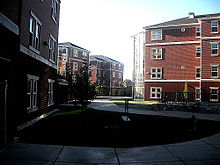
The Living Learning Center on-campus housing complex
Along with Aggie Ice Cream, well-known traditions include the rite of passage of becoming a True Aggie, which requires a student to kiss someone who is already a True Aggie on top of the Block "A." Two students may also become True Aggies together on Homecoming night or on A-Day. At one point recently, USU held the title in the Guinness Book of World Records for the most couples kissing at the same place at the same time. Nearby the Block "A" is the lighted "A" atop the Old Main tower, which shines white throughout the entire valley, and blue on nights when a varsity sport has picked up a victory, or other special events have occurred on campus.
Students have full access to the HPER (pronounced "hyper") and the Nelson Fieldhouse, exercise facilities which include basketball courts, indoor rock climbing, gymnastics equipment, two swimming pools, racquetball, squash, and outdoor field space for rugby, soccer, ultimate, and other sports. USU students are also involved in more than 200 clubs, an active and influential student government, fraternities and sororities, multiple intramural and club sports, and a student-run radio station.
Sustainability
Sustainability efforts on campus are widespread, and include the Aggie Shuttle system, which operates four routes around campus and the neighborhoods nearby. The shuttles also connect to municipal buses that run throughout the Cache Valley and as far away as Preston, Idaho. In addition, Aggie Blue Bikes is a popular student-run program that checks bicycles out to students free of charge for a semester at a time. Since the program began in 2005, commuter traffic on campus has decreased by half.
In the mid-2000s, USU installed natural gas heating plants that have reduced air emissions from 265 tons to less than 20 tons in five years. The university has also retrofitted 3.5 million square feet of space with low-energy light bulbs, which has reduced university costs by a full 30 percent.
For its efforts, Utah State and its "Blue Goes Green" initiative were featured by Princeton Review and the U.S. Green Building Council in their new “Guide to 286 Green Colleges” in 2010.
组织
The University is organized into eight academic colleges:
- Caine College of the Arts (effective 7/1/2010)
- College of Agriculture
- College of Engineering
- College of Humanities, Arts and Social Sciences (reorganizing 7/1/2010)
|
|
- College of Natural Resources
- College of Science
- Emma Eccles Jones College of Education and Human Services
- Jon M. Huntsman School of Business
|
Caine College of the Arts
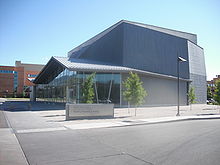
Manon Caine Russell Kathryn Caine Wanlass Performance Hall
Currently, the Caine School of the Arts houses the departments of Art, Music, Theatre Arts, Landscape Architecture and Environmental Planning, Creative Writing, and Interior Design, along with the Nora Eccles Harrison Museum of Art.
Performance facilities include the Chase Fine Arts Center, which houses the Kent Concert Hall among other venues, and the free-standing Manon Caine Russell-Kathryn Caine Wanlass Performance Hall, completed in 2006. The 400-seat Performance Hall, designed by the architectural firm Sasaki Associates, has been praised as one of the best acoustic performance spaces in the American West, and received an Honor Award from the Utah Chapter of the American Institute of Architects. The Nora Eccles Harrison Museum of Art, designed by architect Edward Larrabee Barnes and opened in 1982, contains one of the largest art collections in the Intermountain Region. Its holdings include nationally significant collections of ceramics, Native American art, and especially artworks produced in the American West since 1945.
USU's music program is particularly renowned in the region. Prominent faculty include Department Head Craig Jessop, longtime director of the Mormon Tabernacle Choir, as well as opera singer Michael Ballam, Juilliard-trained pianist Gary Amano, and the Fry Street Quartet, USU's quartet-in-residence.
A January 15, 2010 vote by the Utah Board of Regents approved the split of the College of Humanities, Arts, and Social Sciences into two entities: a yet-to-be-named college of humanities and social sciences, and the Caine College of the Arts. The Caine School has already existed as a non-degree-granting institution since 2005, but will become a free-standing college on July 1, 2010, bringing with it many of HASS's renowned faculty, resources, and programs.
College of Agriculture
The College of Agriculture is known for Nutrition and Food Science research, as well as significant breakthroughs and global outreach in plants and soil science, animal science, veterinary science and economics. College researchers were instrumental in the creation of the first cloned equines (horses), in a project collaboration with researchers at the University of Idaho. The college is also a leader in the international project to classify and research the sheep genome. The departments of the College of Agriculture include the Plants, Soils and Climate Department, Applied Economics Department, the Animal, Dairy and Veterinary Science Department, the Nutrition and Food Science Department, and the Agricultural Systems & Technology Department.
College of Engineering
Much of USU's most widespread academic renown stems directly from the College of Engineering. USU houses the Space Dynamics Laboratory (SDL), which is a research facility focusing on military and science applications. The SDL frequently submits projects to the Department of Defense and NASA. According to recent National Science Foundation statistics, USU ranked first among all universities in the U.S. in funding for aerospace research. USU has also won multiple national aerospace engineering competitions in the past, including two in the 2008–09 academic year alone.
The Utah Water Research Laboratory is the oldest and largest facility of its kind in the nation. USU is considered the world's #1 university in a number of water-related engineering and scientific disciplines due in large part to the UWRL. The lab heads and contributes to numerous international projects, particularly in arid Middle Eastern nations.
College of Humanities, Arts, and Social Sciences
The current College of Humanities, Arts, and Social Sciences (HASS), the largest college at Utah State University, is also its most diverse and touches nearly every student on campus through its teaching of required general education classes. The College has 20 different departments and programs.
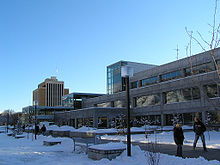
The Merrill-Cazier Library, with the George S. Eccles Business Building looming in the background
In the Humanities, USU has long history in the study of the American West. The university, through its departments of English and History, respectively, is the host institution for the scholarly journals Western American Literature and the Western Historical Quarterly, the official publications of the Western Literature Association and the Western History Association, respectively. The Mountain West Center for Regional Studies, a Humanities outreach center at USU, sponsors public events and research focusing on the cultures and history of the Interior West and larger American West. University Special Collections and Archives, located at the Merrill-Cazier Library, has extensive archival holdings documenting the histories of Utah, the Intermountain West, and The Church of Jesus Christ of Latter-day Saints, as well as one of the nation's largest collections pertaining to American folklore, and the lives and works of western authors such as Jack London and poet May Swenson, a Logan native and USU alumna.
The college also houses the USU Museum of Anthropology, currently located in Old Main.
A January 15, 2010 vote by the Utah Board of Regents approved the split of the College of HASS into two entities: a yet-to-be-named college of humanities and social sciences, and the Caine College of the Arts. The switch will officially take effect on July 1, 2010.
College of Natural Resources
USU has a long and illustrious history in the science and management of forests, rangeland, wildlife, and fisheries and watersheds. Many graduates of the College of Natural Resources have gone on to high-ranking careers in the National Forest Service, National Park Service, and the Bureau of Land Management, and its graduate programs attract overachieving students from many nations. The college also operates the Quinney Library, which houses collections relevant for natural resources education, management, and research.
The College of Natural Resources includes the departments of Watershed Sciences, Environment and Society, and Wildland Resources.
College of Science
Among the most notable aspects of USU's College of Science includes the rate at which its students are accepted into medical and dental schools. Despite the absence of such professional schools on site in Logan, students are admitted to medical and dental programs at a rate of nearly 30 percent above the national average each year. This is due in large part to the rigorous Prehealth Advising Program and resources like the Cadaver Lab, to which undergraduates have access.
In the past decade, the Physics Department alone has produced a Rhodes Scholar, a Marshall Scholar, a Fulbright Student Scholar, nine Goldwater Scholars, and two Carnegie Professors of the Year.
The College of Science houses the Departments of Biology, Chemistry & Biochemistry, Physics, Computer Science, Mathematics & Statistics, and Geology. The Department of Mathematics & Statistics includes one of only three actuarial science programs in the West.
Emma Eccles Jones College of Education and Human Services
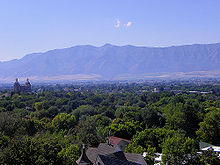
Logan as seen from campus
USU's Emma Eccles Jones College of Education and Human Services has been ranked by U.S. News and World Report in the top 2% of prestigious graduate schools of education in the U.S. for the past decade. The college houses one of America's few combined programs in graduate psychology training, which integrates doctoral-level training across clinical, counseling, and school psychology, and is accredited by the American Psychological Association. Faculty are active in many of areas of psychological research, including neuropsychology, child development, health psychology, and behavior therapy.
Department of Psychology professor Karl R. White is director of the National Center for Hearing Assessment and Management, which focuses on the early identification and intervention of hearing loss in infants and young children.
Jon M. Huntsman School of Business
In 2007, Utah State's College of Business became the Jon M. Huntsman School of Business after a $26 million donation by the philanthropist. The School hopes to model itself after Huntsman's alma mater, the prestigious Wharton School of Business located at the University of Pennsylvania.
The Huntsman School of Business offers a number of graduate and undergraduate degrees in fields including management, accounting, economics and finance, and management information systems (MIS). The bachelor's degrees in entrepreneurship and international business are unique to USU within the state. The prestigious School of Accountancy is distinguished by perennial Top 5 rankings in CPA exam scores by its grad students, as well as its Institute of Management Accountants, which has received a "Gold Level Award of Excellence" for each of the past 14 years, essentially making it the top such institute in the nation. The Huntsman School widely touts its travel programs, including the unique Huntsman Scholar Program, and the impressive transformation it's currently undergoing as it puts its new resources to use. This effort includes the hiring of high-profile faculty, such as Stephen R. Covey, influential management scholar and author of the wildly popular best-seller The Seven Habits of Highly Effective People. Covey begins teaching classes in 2010.
学术
In Fall 2009, Utah State University enrolled 21,680 undergraduate students and 3,385 graduate students. 9,453 of these students were enrolled exclusively at regional campuses or in distance education. USU is home to more Carnegie Professors of the Year than any other school in Utah, and boasts nine of the last 15 for the state. The Carnegie is a teaching award, and in fact, USU strongly stresses close undergraduate involvement for even their most prestigious faculty. According to a recent survey, 49.7% of all faculty teach undergraduates, and 63.5% say they've worked with an undergraduate on a research project in the last two years.
Rankings
|
|
University rankings (overall)
|
|
| ARWU World |
402–501 |
| ARWU North & Latin America |
163–184 |
| Forbes |
191 |
| USNWR National University |
Tier 3 |
| WM National University |
27 |
In recent years, Utah State University has received high national rankings in a diverse array of categories. USU has been ranked 1st in the nation among all public universities, by U.S. News and World Report, for graduates with the least amount of debt. The Princeton Review ranked Utah State among the "Best Western" schools in 2009, and Popular Science called it one of the Top 10 Smartest Schools in the nation. The university also leads the nation in funding for aerospace research and the number of student experiments actually sent out into space. Various entities within the university have received high departmental rankings, such as the Emma Eccles Jones College of Education and Human Services, which ranks 2nd in the nation for total research dollars received by any one college, and in the top 2% for all graduate colleges of education. The athletics program recently won a National Championship for most sports success per dollar spent.
Logan and the surrounding communities also feature prominently on national lists, including #1 safest U.S. metropolitan area, #3 in "Best Cities to Find a Job", and #10 in "Best Small Places for Business and Careers".
Research
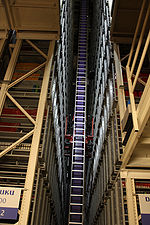
Merrill-Cazier Library's "Borrower's Automated Retrieval Network" (BARN) as viewed from the basement
Utah State University is classified by the Carnegie Foundation as a research university with "high research activity." In addition to its faculty and graduate work, the university strongly emphasizes the importance of undergraduate research. USU's Undergraduate Research program recently celebrated its 35th anniversary, making it one of the oldest such organizations in the nation."
Along with the University of Utah, USU is an anchor in the Utah Science Technology and Research (USTAR) program, which is aimed at optimizing the university and region's most marketable strengths with the goal of bolstering Utah's high-tech economy. Nine USTAR teams currently perform research at Utah State.
Notable research centers based at USU include the Space Dynamics Laboratory, Energy Dynamics Laboratory, Utah Water Research Laboratory, Center for High Performance Computing, Utah Climate Center, Center for Advanced Nutrition, Center for the School of the Future, National Aquatic Monitoring Center, Intermountain Center for River Rehabilitation and Restoration, Mountain West Cetner for Regional Studies, and Utah Botanical Center, among others.
Listed here are some research highlights from recent years.
- In 2005, a Utah State University researcher discovered inorganic aromaticity, a property in chemistry that was initially thought to occur only in organic material. USU chemist Alexander Boldyrev, along with colleague Lai-Sheng Wang, made a breakthrough by discovering aromaticity in inorganic material such as metals. Today, Boldyrev and Wang have made another breakthrough and discovered antiaromaticity, which was a featured article in the April 24 issue of Science magazine.
- A team of USU and University of Idaho researchers were the first in the world to successfully clone an equine. The baby mule, named Idaho Gem, was born May 4, 2003.
- Research efforts are underway to produce a cost-competitive bio-diesel from algae. Lance Seefeldt, along with several fellow USU professors, formed the Biofuels Program at Energy Dynamics Laboratory to develop new and emerging technologies that will produce methane, biodiesel, hydrogen and alcohols from renewable, carbon-dioxide-neutral energy sources, such as consumer and agricultural waste and sunlight.
- Utah State University promotes the OpenCourseWare (OCW) Project (open and free university courses) and developing an open content management system for OCW called eduCommons. This open source content management system is one of the important technology projects in the MIT OpenCourseWare Initiative. eduCommons aids in the creation of OCW sites and has already been adopted by several universities for this purpose.
- During the past few years, on clear nights, one may sometimes see a mysterious green beam of light shooting upward from the USU campus in Logan. The beam is called LIDAR, which stands for "LIght Detection and Ranging". The LIDAR atmospheric observatory, part of the Center for Atmospheric and Space Sciences, is housed in the Science and Engineering Research building. The LIDAR is used in Utah State's study and categorization of atmospheric dynamics.
体育运动
Main article: Utah State Aggies
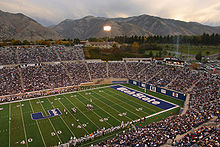
Romney Stadium during an Aggie football game
USU's sports teams are known as the Aggies and are a part of the NCAA Division I Western Athletic Conference (WAC). The official mascot is Big Blue. The university sponsors football, men's and women's basketball, volleyball, softball, women's soccer, track and field, golf, tennis, cross country, and gymnastics. An array of club sports exist as well, and among them, the hockey team is particularly popular with students.
The Aggies have been members of the WAC since 2005 and have won several conference championships in that time, including men's basketball in 2008 and 2009, indoor track in 2008, outdoor track in 2007 and 2009, and cross country each year since joining the conference (2005–10). Women's cross country has also won WAC championships in 2006 and 2008, and women's soccer won in 2008. Utah State has won numerous conference championships in previous conferences. National championships include women's volleyball in 1978 and softball in 1980 and 1981. Immediately previous to the WAC, Utah State was a member of the Big West Conference.
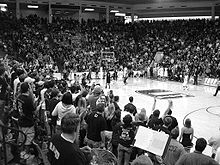
Aggie fans cheer on their team at the Dee Glen Smith Spectrum
The crown jewel of Aggie athletics has long been the men's basketball team, which plays in the Dee Glen Smith Spectrum, which has been called one of the nation's top 5 loudest and toughest places for opposing teams to play. USU basketball is 157–12 at home during the Stew Morrill era, has received 6 NCAA Tournament berths in the last ten years, and has amassed more wins than any team in the nation except Duke, Kansas, and Gonzaga during that time. During the 2008–09 season, USU's ranking in the ESPN/USA Today Coaches' Poll rose as high as #17.
Following the great heights of the 1960s through 1980s, Aggie football has fallen upon hard times in recent years, leading to a disproportionate lack of USU sports coverage in statewide and national media. The decline of the football program has had an extremely negative effect on the perception of the university as a whole, which has resulted in hits to advancement and even academics. It is something that the Aggies are only recently recovering from.
Such recovery efforts spearheaded by new Athletics Director Scott Barnes have included inking deals with TV stations, replacing the head football coach, raising funds, and accomplishing numerous necessary reorganizations, despite the Athletics Department's dismal budget in comparison with other state and WAC schools. In large part due to his efforts, USU Athletics was crowned the 2009 National Champion of the Excellence in Management Cup, which seeks to identify the university that wins the most championships with the lowest expenses.
[edit] Environmentalism
As a major university in the American West, Utah State University students and faculty are concerned with the environment both locally and globally. In reaction to massive oil spills by Exxon Valdez in particular, and the EPA's creation of the Spill Prevention Control and Countermeasure plan (SPCC), USU has created an SPCC with a detailed map of locations, oil types, quantities and containment specifications. They have mapped all possible outfalls from oil storage locations that may impact the waters of the United States. They have developed a plan that utilized engineering controls and emergency spill response to stop all unplanned releases.
Among other things, Utah State University's Environmental Health & Safety Resource Center provides training or resources in dealing with biotoxins such as Anthrax, extensive battery recycling, hazardous waste, mercury thermometer replacement, Indoor Air Quality (IAQ), and much more pertaining to radiation, waste, chemicals, biological, and maintenance.
On January 15, 2010, the university announced the largest private gift in its history when it received ownership of the $30 million-plus Swaner Preserve and EcoCenter outside of Park City. The center consists of a 1,200-acre land trust and a 10,000 square-foot, state-of-the-art facility dedicated to environmental education. The preserve protects critical wetland and foothill terrain in the heart of one of the state’s fastest-growing areas, and the EcoCenter, completed in 2009, is a multi-use facility with space for educational and community activities. The facility is LEED Platinum Certified, the highest standard for design, construction and operation of high-performance green buildings.
Media
Journals published by the university include Utah Science, Western Historical Quarterly, Isotope, and Western American Literary Journal. The Utah State University Press publishes works in composition studies, folklore, Mormon history, Native American studies, nature and environment, and western history.
Two primary print outlets serve the USU student body: (1) The Utah Statesman is sponsored by the university and is published three times per week. The Statesman won best non-daily student paper for region nine in the SPJ awards last year. (2) The Hard News Cafe news website is operated by USU's Department of Journalism and Communications and has won numerous awards for its student reporting, partially because it is often the only entrant in the categories in which it wins.
Utah Public Radio, based at the university, is heard on KUSU (91.5 FM) and KUSR (89.5 FM) in Logan, and throughout Utah on a system of 26 translators. UPR "broadcasts a mix of information, public affairs, and fine arts programming." KUSU is a National Public Radio member station, and an affiliate of Public Radio International. In addition, an entirely student-run radio station called Fusion HD3 broadcasts on the third HD channel of 89.5 in Cache Valley and online.
Aggie Television (ATV) is a cable service lineup of approximately 110 channels offered free of charge to all on-campus residents. ATV produces Crossroads, a bulletin/announcement channel; and Aggie Advantage, providing local and student video programming.
Notable people
Main articles: List of Utah State University alumni, presidents, and faculty
USU has more than 110,000 alumni throughout the United States and in more than 100 other nations.
Particularly notable alumni include Harry Reid, current U.S. Senate Majority Leader; May Swenson, poet; Merlin Olsen, pro football hall-of-famer, actor, and TV personality; Rick Bass, writer and environmental activist; Charlie Denson, President of Nike Brand; Chris Cooley, pro-football tight-end for the Washington Redskins; and Mary L. Cleave, NASA astronaut.
参考文献
- ^ As of June 30, 2009. "U.S. and Canadian Institutions Listed by Fiscal Year 2009 Endowment Market Value and Percentage Change in Endowment Market Value from FY 2008 to FY 2009" (PDF). 2009 NACUBO-Commonfund Study of Endowments. National Association of College and University Business Officers. http://www.nacubo.org/Documents/research/2009_NCSE_Public_Tables_Endowment_Market_Values.pdf. Retrieved March 9, 2010.
- ^ "President's Office". Utah State University. http://www.usu.edu/president/. Retrieved 11 January 2010.
- ^ "USU at a glance". Utah State University. http://aaa.usu.edu/factsfigures/Glance.asp. Retrieved 14 January 2010.
- ^ "Degrees Offered at Utah State University". Utah State University 2007-2009 General Catalog. Utah State University. http://www.usu.edu/generalcatalog/2007-2009/online/pdf/09Degrees.pdf. Retrieved 12 January 2010.
- ^ "Campuses and Centers". Utah State University. http://distance.usu.edu/?campuses. Retrieved 11 January 2010.
- ^ "USU and CEU Create Historic Union". Utah State Today. Utah State University. 4 March 2010. http://www.usu.edu/ust/index.cfm?article=43898. Retrieved 5 March 2010.
- ^ Ricks, Joel Edward (1938). The Utah State Agricultural College: A History of Fifty Years. Salt Lake City, UT: Deseret News Press. pp. 13–20.
- ^ Ricks, Joel Edward (1938). The Utah State Agricultural College: A History of Fifty Years. Salt Lake City, UT: Deseret News Press. pp. 28.
- ^ Parson, Robert. "An Encyclopedic History of Utah State University". http://library.usu.edu/specol/usuarchives/universityhistory.html.
- ^ "A Brief History of Utah State University". Utah State University. http://www.usu.edu/about/history.cfm. Retrieved 13 January 2010.
- ^ Ricks, Joel Edward (1938). The Utah State Agricultural College: A History of Fifty Years. Salt Lake City, UT: Deseret News Press. pp. 98.
- ^ Carr, Jeff (Fall 2009), "President Stan L. Albrecht: Five Years In", Utah State Magazine 15 (3), http://www.utahstate.usu.edu/fall2009/feature1.cfm
- ^ Thayne, Jared (Summer 2007), "Honoring Tradition, Securing Our Future: The Campaign for Utah State University", Utah State Magazine 13 (2), http://www.utahstate.usu.edu/issues/summer07/cover.html
- ^ "Library Portrait: Overview of Merrill-Cazier Library Facilities, Services, and Collections". Utah State University. http://library.usu.edu/main/portrait/index.php. Retrieved 15 January 2010.
- ^ Utah State University Visitor's Guide 2009-2010. Logan, UT: Utah State University. 2009.
- ^ ArchNewsNow (8 August 2006). "Fine Tuning: Utah State University Performance Hall by Sasaki Associates". ArchNewsNow.com. http://www.archnewsnow.com/features/Feature199.htm. Retrieved 12 January 2010.
- ^ Vitale, Tim. "Swaner Preserve & EcoCenter Makes Largest Gift in USU's History". Utah State Today. Utah State University. http://www.usu.edu/ust/index.cfm?article=42009. Retrieved 18 January 2010.
- ^ "USU Housing Services". Utah State University. http://www.housing.usu.edu/. Retrieved 15 January 2010.
- ^ "USU Dining Services". Utah State University. http://www.usu.edu/dining/. Retrieved 15 January 2010.
- ^ "Aggie Ice Cream". Utah State University. http://aggieicecream.usu.edu/. Retrieved 15 January 2010.
- ^ "ASUSU--Associated Students of Utah State University". Utah State University. http://www.usu.edu/asusu/. Retrieved 15 January 2010.
- ^ "Guide to 286 Green Colleges". Princeton Review. http://www.princetonreview.com/green-guide.aspx. Retrieved 21 April 2010.
- ^ "Departments & Programs, Caine School of the Arts". Utah State University. http://www.csa.usu.edu/DeptsAndPrograms.aspx. Retrieved 11 January 2010.
- ^ "Department of Music". Utah State University. http://music.usu.edu/. Retrieved 27 January 2010.
- ^ Williams, Patrick (15 January 2010). "Utah State University Creates New College". Utah State Today. http://www.usu.edu/ust/index.cfm?article=42021. Retrieved 18 January 2010.
- ^ Black, Richard (29 May 2003). "Cloning First for Horse Family". BBC. http://news.bbc.co.uk/2/hi/science/nature/2944920.stm. Retrieved 12 January 2010.
- ^ "Our Departments and Programs, USU College of Agriculture". Utah State University. http://www.ag.usu.edu/htm/about-the-college/our-departments-and-programs. Retrieved 12 January 2010.
- ^ Space Dynamics Laboratory/Utah State University (3 November 2006). "Utah State #1 in Nation for Space Research Funding". Press release. http://www.sdl.usu.edu/news/press/2006/nov3-usu-no1. Retrieved 12 January 2010.
- ^ Utah State University (6 June 2009). "USU Rocket Team Takes National Competition, Two in a Row". Press release. http://www.usu.edu/ust/index.cfm?article=37464. Retrieved 12 January 2010.
- ^ Purser, Annalisa (8 May 2008). "USU Water Research Soars to New Heights". Utah State Today. Utah State University. http://www.usu.edu/ust/index.cfm?article=27066. Retrieved 12 January 2010.
- ^ "Departments & Programs/USU College of Humanities, Arts & Social Sciences". Utah State University. 2009. http://www.hass.usu.edu/DP.aspx. Retrieved 12 January 2010.
- ^ "Journals/USU College of Humanities, Arts & Social Sciences". Utah State University. 2009. http://www.hass.usu.edu/journals.aspx. Retrieved 12 January 2010.
- ^ "College of Natural Resources". USU College of Natural Resources. http://www.cnr.usu.edu/. Retrieved 12 January 2010.
- ^ Carr, Jeff (3 December 2009). "Alumni in Medicine". Utah State Today. Utah State University. http://www.usu.edu/ust/index.cfm?article=40986. Retrieved 12 January 2010.
- ^ "Recent history of achievement by USU physics undergraduates". Utah State University. http://www.physics.usu.edu/peak/Physics_Students_Awards.htm. Retrieved 16 February 2010.
- ^ "Degrees & Majors/USU College of Science". Utah State University. 2009. http://www.usu.edu/science/htm/degrees-majors. Retrieved 12 January 2010.
- ^ "Actuarial Science Schools". Actuary.com. http://www.actuary.com/actuarial-science-schools/. Retrieved 17 February 2010.
- ^ "Rankings: Best Education Programs". U.S. News and World Report. 2009. http://grad-schools.usnews.rankingsandreviews.com/best-graduate-schools/top-education-schools/rankings/page+2. Retrieved 12 January 2010.
- ^ Burgess, Kim (4 December 2007). "A Generous Donation". Herald Journal. http://hjnews.townnews.com/articles/2007/12/04/news/news01.prt. Retrieved 12 January 2010.
- ^ "Full Disclosure: Newsletter of the School of Accountancy". Utah State University. http://www.huntsman.usu.edu/acct/files/uploads/Newsletters/Full%20Disclosure%202009.pdf. Retrieved 12 January 2010.
- ^ Middleton, Diana. "Utah State B-School Hires Stephen Covey". Wall Street Journal. 17 February 2010. http://online.wsj.com/article/SB10001424052748703444804575071921241901894.html. Retrieved 18 February 2010.
- ^ "Enrollment Summary Fall Semester 2009". Utah State University. http://aaa.usu.edu/p&a/EnrolSum/2009-10/Fall09Summary.pdf. Retrieved 14 January 2010.
- ^ "Reception Honors Carnegie Professor of the Year David Peak". Utah State Today. Utah State University. 14 January 2010. http://www.usu.edu/ust/index.cfm?article=41995. Retrieved 15 January 2010.
- ^ Shanghai Jiao Tong University (2009). "Academic Ranking of World Universities". Institute of Higher Education, Shanghai Jiao Tong University. http://www.arwu.org/ARWU2009.jsp. Retrieved 2009-12-23.
- ^ Shanghai Jiao Tong University (2009). "Ranking of North & Latin American Universities". Institute of Higher Education, Shanghai Jiao Tong University. http://www.arwu.org/Americas2009.jsp. Retrieved 2009-12-23.
- ^ "America's Best Colleges". Forbes. 2009. http://www.forbes.com/lists/2009/94/colleges-09_Americas-Best-Colleges_Rank.html. Retrieved 2009-09-13.
- ^ "National Universities Rankings". America's Best Colleges 2009. U.S. News & World Report. 2009. http://colleges.usnews.rankingsandreviews.com/college/national-search. Retrieved 2009-05-18.
- ^ "The Washington Monthly National University Rankings" (PDF). The Washington Monthly. 2009. http://www.washingtonmonthly.com/college_guide/rankings/national_university_rank.php. Retrieved 2009-12-23.
- ^ DeVilbiss, John (30 August 2007). "Utah State University Shines in Rankings". Utah State Today. Utah State University. http://www.usu.edu/ust/index.cfm?article=19295. Retrieved 14 January 2010.
- ^ "Best Western Colleges". Princeton Review. 2009. http://www.princetonreview.com/schoollist.aspx?id=763&page=5&RDN=1. Retrieved 11 January 2010.
- ^ Mika, Eric (12 September 2008). "A Geek's Guide to Colleges". Popular Science. http://www.popsci.com/scitech/article/2008-09/geeks-guide-colleges. Retrieved 14 January 2010.
- ^ "Utah State Wins National Championship for Most Economically Efficient Athletics Department". Aggie Town Square. Utah State University. http://www.usu-tube.com/pages/full_story/push?article-Utah%20State%20Wins%20National%20Championship%20for%20Most%20Economically%20Efficient%20Athletics%20Department%20&id=2866518-Utah%20State%20Wins%20National%20Championship%20for%20Most%20Economically%20Efficient%20Athletics%20Department&instance=topsports. Retrieved 13 January 2010.
- ^ "City Crime Rankings by Population Group". Morgan Quitno. 2006. http://morganquitno.com/cit06pop.htm#METRO. Retrieved 14 January 2010.
- ^ Zupek, Rachel (24 November 2008). "30 Best Cities to Find a Job". CNN/CareerBuilder.com. http://www.cnn.com/2008/LIVING/worklife/11/24/cb.best.cities.find.jobs/index.html. Retrieved 14 January 2010.
- ^ "Best Small Places for Business and Careers". Forbes.com. Forbes. 2007. http://www.forbes.com/lists/2006/5/100135.html. Retrieved 14 January 2010.
- ^ "Carnegie Classifications: Utah State University". Carnegie Foundation for the Advancement of Teaching. http://classifications.carnegiefoundation.org/lookup_listings/view_institution.php?unit_id=230728&start_page=institution.php&clq={%22ipug2005_ids%22%3A%22%22%2C%22ipgrad2005_ids%22%3A%22%22%2C%22enrprofile2005_ids%22%3A%22%22%2C%22ugprfile2005_ids%22%3A%22%22%2C%22sizeset2005_ids%22%3A%22%22%2C%22basic2005_ids%22%3A%22%22%2C%22eng2005_ids%22%3A%22%22%2C%22search_string%22%3A%22utah%22%2C%22first_letter%22%3A%22%22%2C%22level%22%3A%22%22%2C%22control%22%3A%22%22%2C%22accred%22%3A%22%22%2C%22state%22%3A%22%22%2C%22region%22%3A%22%22%2C%22urbanicity%22%3A%22%22%2C%22womens%22%3A%22%22%2C%22hbcu%22%3A%22%22%2C%22hsi%22%3A%22%22%2C%22tribal%22%3A%22%22%2C%22msi%22%3A%22%22%2C%22landgrant%22%3A%22%22%2C%22coplac%22%3A%22%22%2C%22urban%22%3A%22%22}. Retrieved 28 January 2010.
- ^ "Utah State University Undergraduate Research Program Celebrates 35 Years of Hands-On Learning". Utah State University. 26 February 2010. http://research.usu.edu/htm/news/articleID=8747. Retrieved 22 March2010.
- ^ "Pond Scum: Fueling Our Future?". Physorg.com. 30 January 2007. http://www.physorg.com/news89400502.html. Retrieved 19 January 2010.
- ^ "Utah State Basketball". Stew Morrill and AllCoachNetwork.com. http://www.coachstewmorrill.com/program.html. Retrieved 13 January 2010.
- ^ "2009 NCAA Men's Basketball Rankings (Feb. 9)". ESPN.com. http://sports.espn.go.com/ncb/rankings?pollId=2&seasonYear=2009&weekNumber=14&seasonType=2. Retrieved 13 January 2010.
- ^ "Environmental Health and Safety - Environmental". Utah State University. http://ehs.usu.edu/htm/programs-and-services/environmental. Retrieved 11 March 2010.
- ^ "Utah State University Press". Utah State University. http://www.usu.edu/usupress/. Retrieved 12 January 2010.
- ^ "Fusion HD3". Utah State University. http://www.radio.usu.edu/. Retrieved 26 January 2010.
External links
 |
Wikimedia Commons has media related to: Utah State University |
- Utah State University official site
- USU official athletics site



